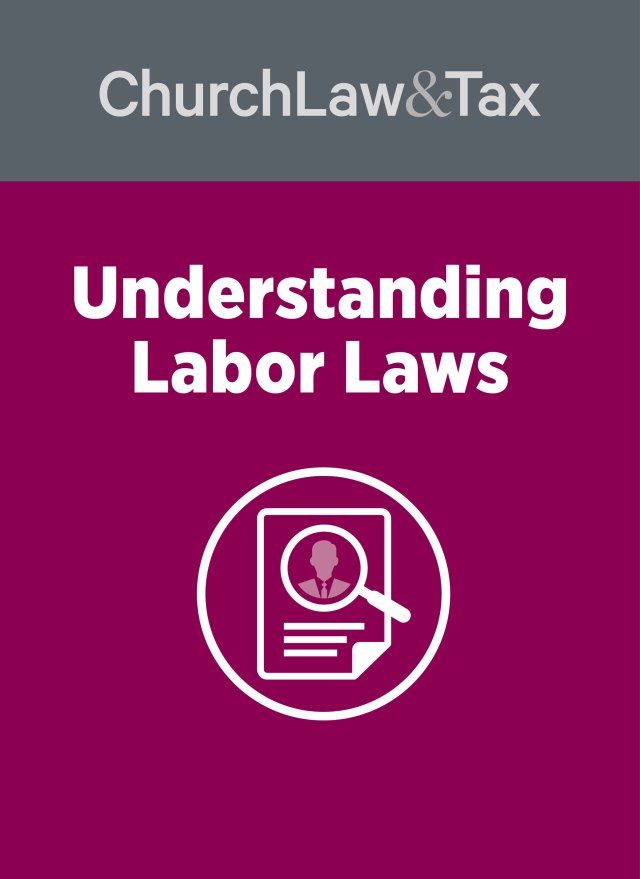• Key point 8-09. The federal Age Discrimination in Employment Act prohibits employers with 20 or more employees, and engaged in interstate commerce, from discriminating in any employment decision on the basis of the age of an employee or applicant for employment who is 40 years of age or older. The Act does not exempt religious organizations. Many states have similar laws that often apply to employers having fewer than 20 employees.
Labor Laws
Employment Practices
• Key point 8-10. The federal Americans with Disabilities Act prohibits employers with at least 15 employees, and that are engaged in interstate commerce, from discriminating in any employment decision against a qualified individual with a disability who is able, with or without reasonable accommodation from the employer, to perform the essential functions of the job. Accommodations that impose an undue hardship upon an employer are not required. Religious organizations may give preference to nondisabled members of their faith over disabled persons who are members of a different faith.
Americans with Disabilities Act
A federal court in Wyoming ruled that a church did not commit unlawful age or disability discrimination when it did not renew the teaching contract of a teacher who had undergone four hip replacement surgeries. A woman (Janet) was hired as a 4th grade teacher at a church-operated school in 1982 and remained employed under a series of annual contracts through 1997, when, at age 50, she was not offered a teaching contract for the 1997-1998 school year. Janet sued the church, claiming that she had been terminated on account of her age and a disability. When Janet was 11 years old, she broke her hip. She had hip replacement surgery in 1959 when she was 12 years old. This was replaced with a new hip in 1974, and was replaced again in 1982. She underwent a fourth hip replacement surgery in 1994, while employed as a teacher at the church-operated school. In 1996, Janet fell and cracked the bone around her prosthesis, but no surgery was required. She was placed on crutches for a period of time to allow healing to occur. It was likely she would require further hip surgeries in the future. In 1997, plaintiff was ill and hospitalized for a strep infection which had settled in her leg. She also received treatment for a blood clot at that time. She did not return to her teaching duties until the middle of March. Janet was able to do most routine daily activities such as shopping, working, laundry, driving, house cleaning, and cooking. She enjoyed camping and limited hiking, but was not able to do certain sports such as skating, skiing, or anything where she was afraid she might fall. Janet insisted that she could perform all of her duties as a teacher, and that her work was not adversely affected by the problems she had experienced with her hip. She maintained her classroom, monitored the playground at lunch and recess, and taught physical education at times.
The church claimed that Janet had not been offered a teaching contract for the 1997-98 school year because of the principal’s opinion that Janet was displaying “poor classroom management and instructional skills.” The principal noted that (1) Janet maintained poor discipline in the classroom, allowed students to make disruptive noise, and that the noise coming from her classroom was not acceptable or appropriate for a fourth grade classroom; (2) Janet ignored the disruptive behavior of the students and would raise her voice in an effort to be heard over talking and other noise, which in turn created more noise; (3) Janet had been counseled for two years concerning these problems, but did not demonstrate satisfactory improvement; (4) school officials were contacted by parents of third graders who claimed that their children would not attend the school if Janet continued to be the fourth grade teacher. The principal believed that Janet was one of the poorest teachers he had ever observed. He was aware of Janet’s hip replacement and that she walked with a limp, but he never observed or believed that her physical condition prevented her from carrying out her teaching responsibilities at the school. He insisted that Janet’s physical condition played no role in his decision not to renew her contract.
Janet also claimed that the church’s decision not to renew her contract was based on her age. She testified, “I am over 50. I had been at [the school] for 13 years, which makes me-I was becoming expensive.” Janet pointed out that she had been replaced by a younger woman who was 35 years of age.
Americans with Disabilities Act (ADA)
The ADA prohibits employers having at least 15 employees and engaged in interstate commerce from discriminating “against a qualified individual with a disability because of the disability of such individual in regard to … discharges of employees … and other terms conditions, and privileges of employment.” The court concluded that Janet was not disabled for purposes of the ADA. The ADA defines a disability as “a physical or mental impairment that substantially limits one or more of the major life activities of such individual.” The court noted that Janet was able to significantly alleviate her hip problems with hip surgeries, and that she could not “identify any major life activity, outside of the work environment, in which she is substantially limited or cannot participate because of her medical condition.” The court concluded:
Notwithstanding [Janet’s] claims that she is in constant pain, which she treats by taking large amounts of ibuprofen and that she generally sleeps sitting in a chair, the court concludes that she is not disabled within the meaning of the ADA. Her own testimony belies her claims in that it demonstrates that she is not substantially limited in any of her major life activities and that it has not prevented her from pursuing her occupation as a teacher. Her impairment must do more than “threaten major life activities of walking, standing, and lifting,” as she has argued in her brief. Furthermore, other than a mere awareness of Janet’s hip problems and her various surgeries … there is nothing in the record to indicate that the church regarded her as having an impairment. The court finds that Janet is not disabled within the meaning of the ADA.
Even if Janet were disabled, the court concluded that the church had a legitimate, nondiscriminatory basis for not renewing her contract (inadequate classroom management and instructional skills). The court noted that Janet “disagrees vehemently” with the principal’s assessments of her abilities as a teacher. However, “it is not plaintiff’s assessment of her abilities as a teacher that is important. The opinions that matter are those of the employer and the decision maker.”
Age Discrimination
If an employer demonstrates a legitimate, nondiscriminatory reason for its employment decision, the burden of proof shifts back to the plaintiff, who must show that age was a “determinative factor” in the employer’s employment decision, or show that the employer’s explanation was merely a “pretext.” When a plaintiff seeks to demonstrate that the employer’s explanation is merely a pretext, the courts require the plaintiff to prove that “the tendered reason for the employment decision was not the genuine motivating reason, but rather was a disingenuous or sham reason.” The court concluded that “there is no credible evidence at all in the record that suggests that the [church’s] employment decisions with respect to Janet had anything to do with age whatsoever …. [Her] argument that she was becoming more expensive to the school as a consequence of her longevity there as a teacher does not satisfy her burden of proof. [Her] self-serving conjecture and speculation do not serve to demonstrate that the employer’s proffered reasons for the challenged actions are pretextual and unworthy of belief. There is no meaningful evidence, direct and indirect, of discrimination against plaintiff by defendant on the basis of age.”
Breach of Contract
The court also rejected Janet’s claim that the church had breached her contract of employment. The court noted that Janet was an “at-will employee” who could be terminated at any time with or without cause. The contract of employment for Janet’s last year of teaching contained the following provision:
This Contract will terminate upon the expiration date set forth above. There has been no representation or any other act on behalf of the School to imply or give the Teacher an expectation that this Contract will be renewed. The Teacher understands that this Contract can only be renewed by an affirmative act of the School Board of the School and no other employee of the School, including the Superintendent or Principal, or any other Board member acting as an individual, has authority to bind the Board. Both parties agree that it is the intention of the Board that no written or unwritten policy or rule of the Board shall give the Teacher an expectation for renewal of this Contract. The Board has the right and may elect not to renew this Contract without cause, in which event the Board will not be obligated to state any reason therefor nor give the Teacher a hearing regarding the decision not to re-employ the Teacher. This Contract shall be final and complete as of the expiration date set forth above.
The contract further provides that “the Teacher hereby represents that he/she has reviewed the terms of this Contract and all the policies of the School, understands the provisions thereof, and agrees to comply with the terms of this Contract and the terms of the School’s Policies and Rules and Regulations, and to perform such duties and services as may lawfully be required of the Teacher.”
The court concluded, “In Wyoming, the courts follow a common law rule of employment at-will. An at-will employment relationship which is of indefinite duration may be terminated by either party, at any time, for any reason or no reason at all, without breaching the contract of employment. An employment relationship may arise by an express contract or an implied in fact contract. The express contract may or may not alter the at-will employment relationship …. Here, the written contract for the 1996-1997 school year is not ambiguous. The contract contains no objective manifestations of assent to an employment contract containing job security provisions; the contract expressly provides for-at-will employment. Janet could not have any expectation of employment beyond … the date that contract terminated, and she could not have had any expectation of anything other than at-will employment under the express terms of that contract.”
Application. This case illustrates that churches, like any employer, can terminate employees so long as they have a legitimate, nondiscriminatory basis. Whenever church leaders decide to dismiss an employee who is a member of a group protected by a federal or state nondiscrimination law, they should be certain that they will be able to prove a nondiscriminatory basis for their decision. The assistance of legal counsel in such cases is definitely advisable. Remember, employment discrimination claims ordinarily are not covered by church liability insurance policies, and this means that the church will have to retain and pay for its own attorney throughout what may be protracted litigation. Brown v. Holy Name Church, 80 F.Supp.2d 1261 (D. Wyo. 2000).
© Copyright 2001 by Church Law & Tax Report. All rights reserved. This publication is designed to provide accurate and authoritative information in regard to the subject matter covered. It is provided with the understanding that the publisher is not engaged in rendering legal, accounting, or other professional service. If legal advice or other expert assistance is required, the services of a competent professional person should be sought. Church Law & Tax Report, PO Box 1098, Matthews, NC 28106. Reference Code: m43 c0301




